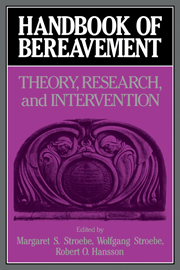Book contents
- Frontmatter
- Contents
- Contributors
- Preface
- Part I Introduction
- Part II The phenomenology and measurement of grief
- Part III Current theories of grief, mourning, and bereavement
- Part IV Physiological changes following bereavement
- Part V The psychological, social, and health impacts of conjugal bereavement
- Part VI Grief reactions to different types of loss
- Part VII Coping, counseling, and therapy
- 23 The meaning of loss and adjustment to bereavement
- 24 Old age and widowhood: Issues of personal control and independence
- 25 The support systems of American urban widows
- 26 The role of social support in bereavement
- 27 Bereavement self-help groups: A review of conceptual and methodological issues
- 28 Counseling and therapy of the bereaved
- Part VIII Conclusions
- References
- Author index
- Subject Index
26 - The role of social support in bereavement
Published online by Cambridge University Press: 04 May 2010
- Frontmatter
- Contents
- Contributors
- Preface
- Part I Introduction
- Part II The phenomenology and measurement of grief
- Part III Current theories of grief, mourning, and bereavement
- Part IV Physiological changes following bereavement
- Part V The psychological, social, and health impacts of conjugal bereavement
- Part VI Grief reactions to different types of loss
- Part VII Coping, counseling, and therapy
- 23 The meaning of loss and adjustment to bereavement
- 24 Old age and widowhood: Issues of personal control and independence
- 25 The support systems of American urban widows
- 26 The role of social support in bereavement
- 27 Bereavement self-help groups: A review of conceptual and methodological issues
- 28 Counseling and therapy of the bereaved
- Part VIII Conclusions
- References
- Author index
- Subject Index
Summary
Bereavement is a social network crisis. The vacuum created through the loss of a significant relationship, especially in a closed network, will draw the entire group into distress. The joint experience of suffering may render network members unable to support the individual for whom the loss is most immediate and profound.
The finding that the single best predictor of high distress 1 month after bereavement was a lack of contact with old friends who had often dropped away during a protracted period of illness (Vachon, 1979) underscores the importance of network support in the days following bereavement. Moreover, a deficit in social support has been associated with poor outcome in bereavement as measured by poor health in the first bereavement year (Maddison & Walker, 1967; Maddison, Viola, & Walker, 1969; Raphael, 1983), continued high distress 2 years after bereavement (Vachon et al., 1982b), an increased use of antianxiety medications (Mor, McHorney, & Sherwood, 1986), and for those who have lost a spouse, more strain in adjusting to the new role of being both single and a widowed person (Bankoff, 1986).
This chapter reviews the literature on social support as it applies to those bereaved through the death of a spouse, in order to examine the interaction of the bereaved with members of their social network and the perceived helpfulness of that network. Formal and informal support efforts that do and do not facilitate adaptation to bereavement are considered.
- Type
- Chapter
- Information
- Handbook of BereavementTheory, Research, and Intervention, pp. 397 - 410Publisher: Cambridge University PressPrint publication year: 1993
- 61
- Cited by



